The Year of Reading Proust discussion

This topic is about
Time Regained
Time Regained, vol. 7
>
Through Sunday, 22 Dec.: Time Regained
 Marcel Proust was mortal & he was not Outside Time, but his art was and his characters were; even Swann who was forgotten by some of his descendants in the novel became 'immortal'. If you recall, Proust addressed one of Swsnn's models, Charles Haas in the the 1868 Tissot painting, saying that Swann, his fictional derivative, will be remembered--be Outside of Time--while the real Haas will be forgotten.
Marcel Proust was mortal & he was not Outside Time, but his art was and his characters were; even Swann who was forgotten by some of his descendants in the novel became 'immortal'. If you recall, Proust addressed one of Swsnn's models, Charles Haas in the the 1868 Tissot painting, saying that Swann, his fictional derivative, will be remembered--be Outside of Time--while the real Haas will be forgotten.Proust was writing some 40 years after the painting was finished and recorded the forgetting of Swann in the novel as what really happened to Haas in life.
Memory of the past recorded by art, even if it is forgotten in the present, is Outside of Time.

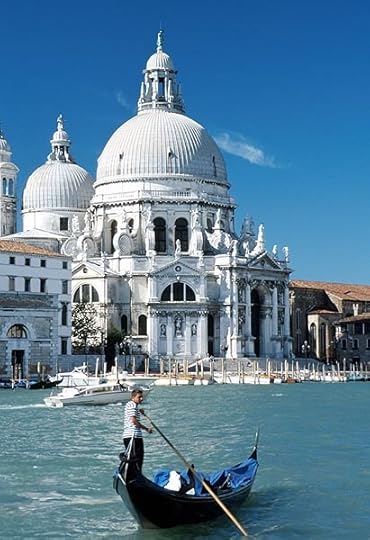
Santa Maria della Salute, Venice.
Rukin on La Salute:
One of the earliest buildings of the Grotesque Renaissance, rendered impressive by its position, size and general proportions. These latter are exceedingly good; the grace of the whole building being chiefly dependent on the inequality of the size in its cupolas, and the pretty grouping of the two campaniles behind them.
Proust on La Salute:
.. comme ces monuments -- La Salute par example -- qui sans grande beauté propre font admirablement là où ils sont situés,...p. 386-387.
 Salon de Thé Colombin...
Salon de Thé Colombin...... Swann, quand il n'aima plus Mme Swann mais une femme qui servait du thé chez ce même Colombin... p. 376
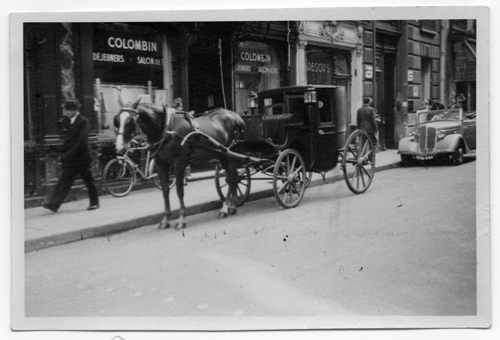
It seems Marguerite Yourcenar also went there for tea.
 I am rereading the introduction of Karpeles book, and he mentions:
I am rereading the introduction of Karpeles book, and he mentions:Proust claimed to know by heart Ruskin's portrait of his early development , a volume called Praeterita: The Autobiography Of John Ruskin (which could be loosely translated as "Lost Time" or "Things Past"). The degree to which this memoir's tone of voice would today be called "Proustian" is an indication of how much Ruskin's writing influenced him..
But then reminds us of how Proust eventually got tired of Ruskin, for equating art and morality.
 I find this volume and especially the second part absolutely 'sublime',to use St Loup's favorite epithet. As Marcus said earlier, it is so full of insights, which for the Narrator are simple statements of facts. More than in any of the previous volumes, Proust's notion that the reader is reading about himself rings so true. It has such universal appeal.
I find this volume and especially the second part absolutely 'sublime',to use St Loup's favorite epithet. As Marcus said earlier, it is so full of insights, which for the Narrator are simple statements of facts. More than in any of the previous volumes, Proust's notion that the reader is reading about himself rings so true. It has such universal appeal.It took quite a leap of faith for me to believe that the characters had changed so much that the narrator had trouble recognizing some of them. Mark Twain's saying kept popping in my mind. "The difference between truth and fiction is that fiction has to make sense." It sounds as if the narrator had been away treating his asthma for 50 years.
Of course, we have noted earlier that Proust was not obsessively concerned with timelines or chronological clues. I remember how we tried to figure out how old the narrator was at the beginning of 'A l'ombre..'
 In trying to find the answer to the "cubist woman," I discovered this...
In trying to find the answer to the "cubist woman," I discovered this..."Comte and Comtesse Étienne de Beaumont give a New Year’s Eve party. Marcel Proust arrives about midnight. Jean Hugo tells us: 'He had entered with the New Year, the year of his death . . . His pale face had become puffy; he had developed a paunch. He spoke only to dukes. "Look at him," Picasso said to me, "he’s pursuing his theme"' (Jean Hugo, Avant d’oublier [Paris: Fayard, 1976], p. 127)."
http://www.philamuseum.org/exhibition...
Another take:
"PICASSO and Olga saw 1922 in at a New Year's Eve party given by the Count de Beaumont. Midnight approached, and one of the most important guests had not yet arrived. The host announced that Céleste, Marcel Proust's housekeeper, had just telephoned for the tenth time, to find out if the house was drafty and if the herb tea for which she had given the recipe was ready. 'Finally at midnight,' wrote the painter Jean Hugo in his diary, 'there was a sort of stir in the crowd and we knew that Proust had arrived. He had entered together with the new year, the year of his death.... His pale face had become puffy; he had developed a paunch. He spoke only to dukes."'Look at him," Picasso said to me, "he's still on his theme."' Picasso may not have read Proust, but he had absorbed him."
Arianna Stassinopoulos Huffington
http://www.theatlantic.com/past/unbou...
Tadié's biography, Jean Hugo "'Look at him, Picasso said to me, 'he's keeping his eye out for models.'" (p 749)
 Kalliope wrote: "And now, who is he referring to? - Marcelita may know..
Kalliope wrote: "And now, who is he referring to? - Marcelita may know..Who is this lady who lives locked up in an apartment and is surrounded by Cubist paintings?....."
Stein is not mentioned in the biographies...nor could I find anything about the "cubist woman."
However, as Time Regained was written early, I thought one model "could be" Fernande Olivier. However, if Proust re-wrote/added the passage, then there is Olga Khokhlova (Spring 1917). Naturally, Proust could be writing about another cubist painter and not Picasso.
The key would be when Proust wrote this passage:
"And often these fair-haired dancers had acquired, along with a wig of white hair, the friendship of duchesses whom in the past they had not known. Nor was this all: having in their youth done nothing but dance, they had been 'touched' by art as once a noble lady might have been touched by grace. And as the seventeenth-century lady, when this happened,
withdrew into a life of religion, so now her descendant lived in an apartment filled with cubist paintings, a cubist painter worked for her alone and she lived only for him." MP pp. 367-68
"Fernande's presence, which the artist fiercely guarded, even to the extent of locking her up when he went out, was clearly essential to him during these years of artistic and personal struggle."
http://www.nytimes.com/2001/08/05/boo...
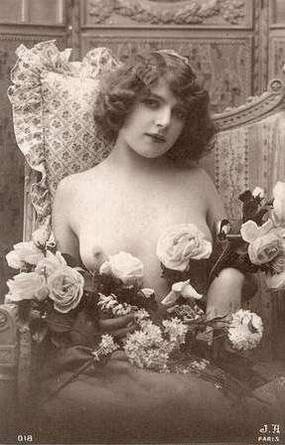
http://www.zaidan.ca/Art_Gallery/Pica...

Fernande Olivier, Picasso and Ramon Reventos, 1906
"Fernande (Olivier) modeled for other artists between 1900 & 1905, when she moved in with Picasso, who would not allow her to model for other artists."
http://bjws.blogspot.com/2011/06/evol...
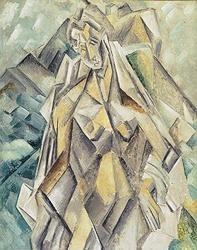
Pablo Picasso's painting of Fernande Olivier.
Female Nude, Horta de Ebro, summer 1909
© 2003 Estate of Pablo Picasso / Artists Rights Society (ARS), New York
http://www.nga.gov/exhibitions/2003/s...
 Kalliope wrote: "Marcus wrote: "Kalliope wrote: "No ExitAnother mention of the mirror element, which should please Marcus.,..
Kalliope wrote: "Marcus wrote: "Kalliope wrote: "No ExitAnother mention of the mirror element, which should please Marcus.,..We do not see our own aspect. We only see the way the others look, throu..."
Ah, hence the quote "hell is other people" i get it now!
 Jocelyne wrote: "I find this volume and especially the second part absolutely 'sublime',to use St Loup's favorite epithet. As Marcus said earlier, it is so full of insights, which for the Narrator are simple statem..."
Jocelyne wrote: "I find this volume and especially the second part absolutely 'sublime',to use St Loup's favorite epithet. As Marcus said earlier, it is so full of insights, which for the Narrator are simple statem..."insights as statements of facts for MP...exactly, Jocelyne, though of course he's had to dream deep for them.
 Marcus wrote: "insights as statements of facts for MP...exactly, Jocelyne, though of course he's had to dream deep for them. ..."
Marcus wrote: "insights as statements of facts for MP...exactly, Jocelyne, though of course he's had to dream deep for them. ..."I had a dream last night after which I woke briefly, and grasping at the wisps that remained, I was concious that Swann figured prominently. Then I drifted back to sleep, and when I finally woke, I found I'd been dreaming about Swann, and I remembered waking in the night and having that same experience. Then I thought of Martin's comment last week about the Narrator possibly drifting in and out of a very long dream, and it seemed it might be possible, and if so, as in my own dream, Swann would be the most important element.
Thomas Mann has a very interesting theory about narrative time which I may post here when I'm back on my Mac. He compares narrative time to the way time can stretch in the dreams of opium-eaters, up to even spans of sixty years. This reminded me of the way time stretches and contracts in our Narraotor's narrative. And we know that Proust took opium.
@jocelyne, I thought of theRip van Winkle story when reading the scenes in the Guermantes matinée.
@Marcelita, it's interesting that Picasso kept Fernande locked up at his studio when he went out....
@Kalliope, that parallel in the two descriptions of Santa Maria Della Salute is..., well, it's clear that one writer influenced the other.
 Marcelita, I know that you know the Recherche inside out, having read it many times. Perhaps there are others in the discussion who have also read it before or who have read the critics and therefore understand fully Proust's themes. I just want to say to you all that I am grateful for the restraint you've shown during the year in not revealing anything that might have spoiled the experience for us first time readers who, little by little, and not without stumbling down a few blind alleys, have been able to enjoy the satisfaction of figuring out the themes for ourselves. Thank you.
Marcelita, I know that you know the Recherche inside out, having read it many times. Perhaps there are others in the discussion who have also read it before or who have read the critics and therefore understand fully Proust's themes. I just want to say to you all that I am grateful for the restraint you've shown during the year in not revealing anything that might have spoiled the experience for us first time readers who, little by little, and not without stumbling down a few blind alleys, have been able to enjoy the satisfaction of figuring out the themes for ourselves. Thank you.
 This quote by Thomas Mann in The Magic Mountain - about a youg man in a sanatorium for respiratory illnesses - elaborates Mann's approach to narrative time, and I think the quote is relevant to Proust, so please excuse me posting such a long piece here:
This quote by Thomas Mann in The Magic Mountain - about a youg man in a sanatorium for respiratory illnesses - elaborates Mann's approach to narrative time, and I think the quote is relevant to Proust, so please excuse me posting such a long piece here:Narrative, however, has two kinds of time: first, its own real time, which like musical time defines its movement and presentation; and second, the time of its contents, which has a perspective quality that can vary widely, from a story in which the narrative’s imaginary time is almost, or indeed totally coincident with its musical time, to one in which it stretches out over light-years.
A musical piece entitled “Five Minute Waltz” lasts five minutes - and this only defines its relationship to time. A story whose contents involved a time span of five minutes, however, could, by means of an extraordinary scrupulosity in filling up those five minutes, last a thousand times as long - and still remain short on boredom, although in relation to its imaginary time it would be very long in the telling. On the other hand, it is possible for a narrative’s content time to exceed its own duration immeasurably.This is accomplished by diminishment - and we use this term to describe an illusory, or, to be quite explicit, diseased element, that is obviously pertinent here: diminishment occurs to some extent whenever a narrative makes use of hermetic magic and a temporal hyperperspective reminiscent of certain anomalous experiences of reality that imply that the senses have been transcended. The diaries of opium-eaters record how, during the brief period of ecstasy, the drugged person's dreams have a temporal scope of ten, twenty, thirty, sometimes sixty years or even surpass all limits of man's ability to experience time - dreams, that is, whose imaginary time span vastly exceeds their actual duration and which are characterised by an incredible diminishment of the experience of time, with images thronging past so swiftly that, as one hashish-smoker puts it, the intoxicated user's brain seems 'to have had something removed, like the mainspring from a broken watch.' A narrative, then, can set to work and deal with time in much the same way as those depraved dreams. But since it can "deal" with time, it is clear that time, which is the element of the narrative, can also become its 'subject'; and although it would be going too far to say that one can 'narrate time', it is apparently not such an absurd notion to want to narrate 'about time' - so that a term like 'time novel' may well take on an oddly dreamlike double meaning. Thomas Mann
 Oh will you want to read this find!!!
Oh will you want to read this find!!!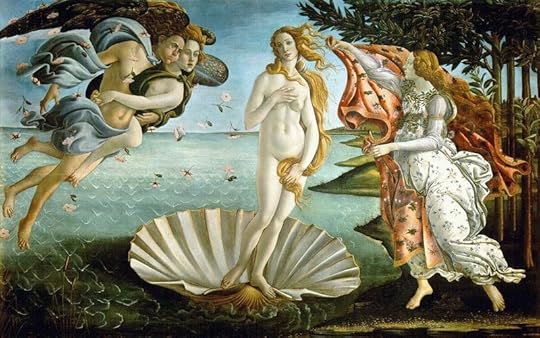
It depicts the goddess Venus, having emerged from the sea as a fully grown woman, arriving at the sea-shore (which is related to the Venus Anadyomene motif.
[image error]
http://www.academia.edu/3277601/Prous...
http://amoleskine.tumblr.com/post/339...
@Manny and Kalliope, there is a very interesting reference to Kant.
This really ties together so many themes introduced and discussed by you all over the year! And so much more!No spoilers.
@ReemK10(PaperPills) BRAVO! lol Enjoy!
 Fionnuala wrote: "This quote by Thomas Mann in The Magic Mountain - about a youg man in a sanatorium for respiratory illnesses - elaborates Mann's approach to narrative time, and I think the quote is relevant..."
Fionnuala wrote: "This quote by Thomas Mann in The Magic Mountain - about a youg man in a sanatorium for respiratory illnesses - elaborates Mann's approach to narrative time, and I think the quote is relevant..."Curious...searching...Mann...bisexuality...Death in Venice...Visconti (who wanted to film Pinter's screenplay: http://books.google.com/books?id=RM5B... )..."Looking for Tadzio" documentary...with scenes of Venice starting @21:15. (Scroll to bottom left: http://www.tadziospeaks.co.uk/real.htm)
The true story of Mann watching the 10-year old Władysław Moes at the Grand Hotel des Bains, Lido-Venice in 1911, which was memorialized as the 50-year-old Aschenbach watching the 14-year-old Tadzio in the novella, "Death in Venice," reminded me of the Baron de Charlus watching the narrator in Balbec.
 Throwing this out there... Could Proust have been referring to Modigliani and this painting?
Throwing this out there... Could Proust have been referring to Modigliani and this painting?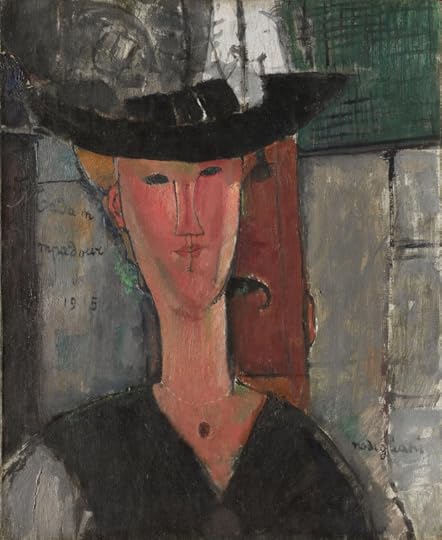
In the "Madame Pompadour - Portrait of Beatrice Hastings," Modigliani rendered 'Cubism' by simultaneously depicting the sides of the face through different viewpoints, as well as having a collage effect with the writings on stonewall.
Article Source: http://EzineArticles.com/2341225
Amedeo Modigliani
Italian, 1884–1920
Madam Pompadour, 1915
Oil on canvas
24 1/16 x 19 3/4 in. (61.1 x 50.2 cm)
Signed, l.r.: "modigliani"; inscribed and dated, l.c.: "Madam/Pompadour/1915"
Joseph Winterbotham Collection, 1938.217
http://ezinearticles.com/?His-Most-Fa...
Modigliani was exhibiting, trying to sell his work, and looking for a dealer. No longer was the Salon, that fortress of the artistic establishment, the only place an artist could exhibit, or even the Salon des Réfusés, established by the Impressionists in the 1860s. Now there was the Salon des Indépendants, established by such artists as Georges Seurat, Odilon Redon, and Paul Signac. And there was yet another anti-establishment venue, the Salon d’Automne. The creation of a prominent architect and writer, Fritz Jourdain, the Salon d’Automne attracted a socially prominent crowd when it opened its doors in October 1903. At the Petit Palais, Proust, in white tie and tails, mingled with the politician Léon Blum and the aristocratic Comtesse de Noailles. It was a success on every count and became at once a major goal of every young unknown. In 1907 the Salon accepted seven works by Modigliani: the portrait of his friend the German artist Ludwig Meidner, a Study of a Head, and five watercolors.
Modigliani was born into a Jewish family in Livorno, Italy. A port city, Livorno had long served as a refuge for those persecuted for their religion, and was home to a large Jewish community. His maternal great-great-grandfather, Solomon Garsin, had immigrated to Livorno in the 18th century as a refugee.[1]
Modigliani's mother (Eugénie Garsin), who was born and grew up in Marseille, was descended from an intellectual, scholarly family of Sephardic Jews, generations of whom had resided along the Mediterranean coastline. Her ancestors were learned people, fluent in many languages, known authorities on sacred Jewish texts, and founders of a school of Talmudic studies. Family legend traced the Garsins' lineage to the 17th-century Dutch philosopher Baruch Spinoza.
 Marcelita wrote: "..The true story of Mann watching the 10-year old Władysław Moes at the Grand Hotel des Bains, Lido-Venice in 1911, which was memorialized as the 50-year-old Aschenbach watching the 14-year-old Tadzio in the novella, "Death in Venice," reminded me of the Baron de Charlus watching the narrator in Balbec. ."
Marcelita wrote: "..The true story of Mann watching the 10-year old Władysław Moes at the Grand Hotel des Bains, Lido-Venice in 1911, which was memorialized as the 50-year-old Aschenbach watching the 14-year-old Tadzio in the novella, "Death in Venice," reminded me of the Baron de Charlus watching the narrator in Balbec. ."Brilliant, Marcelita! Yet another example to add to the list I made recently of
the parallels between Mann and Proust as a result of reading The Magic Mountain and attempting to review it. There are just so many areas of common ground between their work and yet, they were writing at the same time, more or less, and could hardly have been reading each other. That makes me wonder if they might have been reading the same books, and Freud comes immediately to mind. Kalliope might say Bergson and Kant, perhaps...
 I think Beatrice Hastings was the descendent and not Fernande Olivier:
I think Beatrice Hastings was the descendent and not Fernande Olivier:http://modernartconsulting.ru/en/2013...
 ReemK10 (Paper Pills) wrote: "I think Beatrice Hastings was the descendent and not Fernande Olivier..."
ReemK10 (Paper Pills) wrote: "I think Beatrice Hastings was the descendent and not Fernande Olivier..."I love the portrait of B Hastings, Reem.
 ReemK10 (Paper Pills) wrote: "I think Beatrice Hastings was the descendent and not Fernande Olivier. "
ReemK10 (Paper Pills) wrote: "I think Beatrice Hastings was the descendent and not Fernande Olivier. "I don't know...all these white mice! Picasso had one also.
Anyway, she certainly is interesting, but wonder about "...and she lived only for him." MP pp. 367-68
"Their relations were dazzling and temperamental. She believed that she did not have to belong to anyone, while he was violently jealous, often without any grounds – it was enough for Beatrice to simply speak English to somebody."
http://modernartconsulting.ru/en/2013...
Sounds like Saint-Loup and Rachel. ;)
 Marcelita wrote: "Kalliope wrote: "And now, who is he referring to? - Marcelita may know..
Marcelita wrote: "Kalliope wrote: "And now, who is he referring to? - Marcelita may know..Stein is not mentioned i..."
Very interesting, Marcelita, that your interpretation of the “illustred dames” who lived amongst cubist paintings has gone more towards the model. I took it as a reference to the owner or patron... But patronage of Cubism was very secluded in its beginnings.
As you say, we don’t know if he is thinking of Picasso, and in which years he wrote this particular section. There were two grouping of artist developing cubism at the very beginning, Picasso &Braque (Montmartre) and a loose and open grouping of artists and critics with figures such as Apollinaire, Gleizes, Metzinger, etc.., who gathered in Montparnasse and who were trying to imagine what they heard the Montmartre group were doing.
My take on Picasso’s attitude towards Fernande Olivier, is that if she became “captive” it was less out of amorous concerns, than out of Picasso’s zeal over his work. He just did not want anyone to know what he was doing before he was ready to show it to his dealers. A model who would sit around different studios was a channel of communication that Picasso would want to avoid.
It would be similar to industrial espionage. Imagine Apple Computer in the Product Development section letting one of its employees work part time in another computer company.
 Marcelita wrote: "Fionnuala wrote: "This quote by Thomas Mann in The Magic Mountain - about a youg man in a sanatorium for respiratory illnesses - elaborates Mann's approach to narrative time, and I think the quote ..."
Marcelita wrote: "Fionnuala wrote: "This quote by Thomas Mann in The Magic Mountain - about a youg man in a sanatorium for respiratory illnesses - elaborates Mann's approach to narrative time, and I think the quote ..."Very true... Very good parallel..., and since I watched yesterday Raoul Ruiz's film, that scene of Charlus watching the Narrator is so very beautifully rendered.
 Fionnuala wrote: "Marcelita wrote: "..The true story of Mann watching the 10-year old Władysław Moes at the Grand Hotel des Bains, Lido-Venice in 1911, which was memorialized as the 50-year-old Aschenbach watching t..."
Fionnuala wrote: "Marcelita wrote: "..The true story of Mann watching the 10-year old Władysław Moes at the Grand Hotel des Bains, Lido-Venice in 1911, which was memorialized as the 50-year-old Aschenbach watching t..."Funny the way ideas circulated...
It is like some of the ideas found in Susan Sontag (at least on photography) can be traced to Barthes, and then to Walter Benjamin... And now, having read Proust, some of the ideas usually ascribed to Benjamin seem to me to be present in Proust.
Benjamin was the first translator of Proust into German.
 ReemK10 (Paper Pills) wrote: "Oh will you want to read this find!!!
ReemK10 (Paper Pills) wrote: "Oh will you want to read this find!!!It depicts the goddess Venus, having emerged from the sea as a fully grown woman, arriving at the sea-shore (which is related to the Venus Anadyomene mot..."
Will come back to these after next week, Reem.. May be you can post it in the Posts section, which I will visit properly once we are done..
 I think this is the first time he mentions the Panama affair. It had surprised me that it had not featured so far, given the attention he gave to the Dreyfus affair.
I think this is the first time he mentions the Panama affair. It had surprised me that it had not featured so far, given the attention he gave to the Dreyfus affair.There is a just an allusion, and which the footnotes elaborate further...
.. un ministre d'avant l'époque Boulangiste... Cet ancien président du Conseil, si bien reçu dans le faubourg Saint-Germain avait jadis été l'objet de poursuites criminelles... p. 357.
 Kalliope wrote: "Marcelita wrote: "Kalliope wrote: "And now, who is he referring to? - Marcelita may know..
Kalliope wrote: "Marcelita wrote: "Kalliope wrote: "And now, who is he referring to? - Marcelita may know..Stein is not mentioned i..."
"...took it as a reference to the owner or patron..."
Yes, I can understand.
I read it as a love affair, being an incurable. ;)
The passage:
"And often these fair-haired dancers had acquired, along with a wig of white hair, the friendship of duchesses whom in the past they had not known.
Nor was this all: having in their youth done nothing but dance, they had been 'touched' by art as once a noble lady might have been touched by grace.
And as the seventeenth-century lady, when this happened, withdrew into a life of religion, so now her descendant lived in an apartment filled with cubist paintings, a cubist painter worked for her alone and she lived only for him." MP pp. 367-68
 There is something sad when the Narrator realizes that even "le nom" can lose its identity or be stolen.
There is something sad when the Narrator realizes that even "le nom" can lose its identity or be stolen.La succesion au nom est triste comme toutes les successions, comme toutes les usurpations de propriété... le nom refermant sur celles qui sombrent de temps à autre sa toujours pareille placidité immémoriale. pp365-366.
 Related to the post above, the "nom" can also undergo the effects of change.
Related to the post above, the "nom" can also undergo the effects of change.There is this beautiful passage.
Ainsi à tous les moments de la durée, le nom de Guermantes, considéré comme un ensemble de tous les noms qu'il admettait en lui, autour de lui, subissait des déperditions, recrutait des éléments nouveaux comme ces jardins où à tout moment des fleurs à peine en bouton, et se préparent à remplacer celles qui se flétrissaient déjà, se confondent dans une masse qui semble pareille, sauf à ceux qui n'ont pas toujours vu les nouvelles venues et gardent dans leur souvenir l'image précise de celles qui ne sont plus. p. 382.
 Marcelita wrote: "
Marcelita wrote: ""...took it as a reference to the owner or patron..."
,..."
Well, I think it can go either way, Marcelita. Hard to say.. I think I took the path of the patron because Cubism is such an intellectual art and Picasso was such an egotist.
 As for Marie Anoinette and her Austrian nose (nez autrichien), I immediately thought of the tragic drawing by JL David.
As for Marie Anoinette and her Austrian nose (nez autrichien), I immediately thought of the tragic drawing by JL David.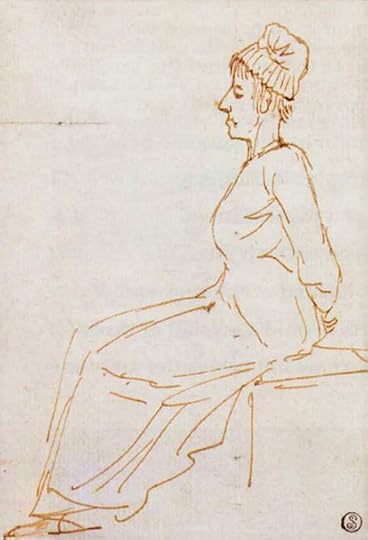
But there is also this one..., by Louis Charles Ruotte.
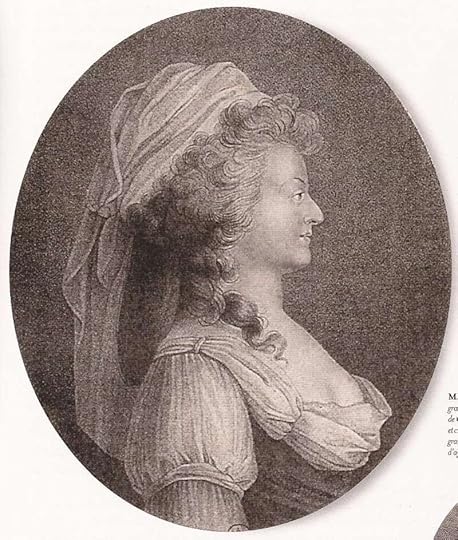
 It has been mentioned several times along the several volumes the theatrical element in the novel.
It has been mentioned several times along the several volumes the theatrical element in the novel.And now even the war is associated to a theatre piece... And it was Saint-Loup, who, though a participant in the war, would use this image.
Quelques instants auparavant, Robert comparait devant moi les batailles à des pièces où il n'est pas toujours facile de savoir ce qu'a voulu l'auteur,où lui-même a changé son plan en cours de route.... Et chacun pouvant refaire une pièce à sa manière... p. 394..
Of course Proust himself changed the path in his novel as he wrote it.. and took many more "détours" than originally planned.
And goes on to the different interpretation given to Molière's Le Misanthrope, when the actor Coquelin told another actor, Mounet-Sully, that the play was not supposed to be serious, and that Molière himself, when he played the role of the Misanthrope himself, gave to it a comic nature...
Benoît Constant Coquelin (1841-1909)
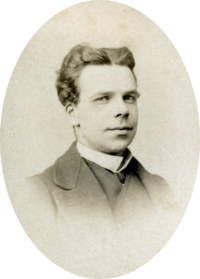
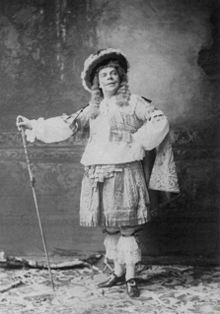
Jean Mounet-Sully (1841-1916)

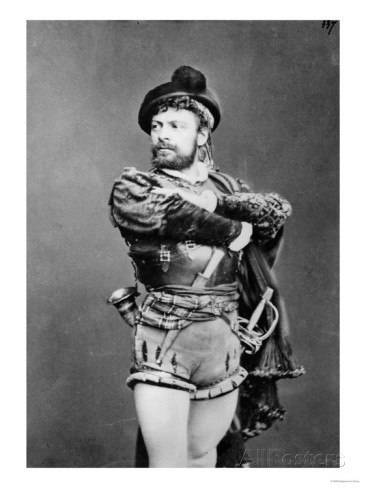
 Marcus wrote: "Kalliope wrote: "]Another mention of the mirror element, which should please Marcus.,..
Marcus wrote: "Kalliope wrote: "]Another mention of the mirror element, which should please Marcus.,....."
And more mirrors, Marcus...
...les images que nous voyons assemblées quelque part son généralement le reflet ou d'une façon quelconque l'effet, d'un premier groupement assez différent quoique symétrique d'autres images, extrêmement éloigné du second. p. 397.
 Fionnuala wrote: "This quote by Thomas Mann in The Magic Mountain - about a youg man in a sanatorium for respiratory illnesses - elaborates Mann's approach to narrative time, and I think the quote is relevant to Pro..."
Fionnuala wrote: "This quote by Thomas Mann in The Magic Mountain - about a youg man in a sanatorium for respiratory illnesses - elaborates Mann's approach to narrative time, and I think the quote is relevant to Pro..."This is fascinating, Fio. This reminds me of a book I once read on dreams and in which the author recounted a dream about a man being involved in the French revolution. The dream description took at least 12 pages and was incredibly rich in details about all manner of alliances, escapes, historical and atmospheric elements, and the dream ended with the dreamer being guillotined. In the moment the blade of the guillotine fell on the dreamer's neck, the dreamer woke up: the headboard had fallen on his head. The author explained this, if I remember correctly, by the incredible contraction of narrative details in what must have been a split second.
By the way, you have a more interesting unconscious than I!
 Fionnuala wrote: "Marcelita, I know that you know the Recherche inside out, having read it many times. Perhaps there are others in the discussion who have also read it before or who have read the critics and therefo..."
Fionnuala wrote: "Marcelita, I know that you know the Recherche inside out, having read it many times. Perhaps there are others in the discussion who have also read it before or who have read the critics and therefo..."Yes, absolutely! Thank you, Marcelita. I can just imagine how sometimes you must be itching to just correct us or lead us back on track.
 Kalliope wrote: "Related to the post above, the "nom" can also undergo the effects of change.
Kalliope wrote: "Related to the post above, the "nom" can also undergo the effects of change.There is this beautiful passage.
Ainsi à tous les moments de la durée, le nom de Guermantes, considéré comme un ensemb..."
I think my post just vaporized. Sorry, if it is a repeat. I noted this beautiful passage too. How sad and wistful.
Antoine Compagnon devotes an hour to the shape of noses, especially the semitic nose.
 Marcus wrote: "Eugene wrote: "..."Gracious me, it appears to be true that poor Madame d'Arpajon is dead." Even the people who did not need this death to make them feel any joy in being alive, were rendered happy ..."
Marcus wrote: "Eugene wrote: "..."Gracious me, it appears to be true that poor Madame d'Arpajon is dead." Even the people who did not need this death to make them feel any joy in being alive, were rendered happy ..."Marcus wrote: Eugene, thanks for quoting this, in particular the "For every death is for others a simplification of life" part...What is a particular feature of Proust for me is that insights like this are presented in quite a matter of fact way, not held up as "INSIGHTS".
Yes...unblinking, unapologetic, courageously, truthful. I just re-read much of last week's section this morning. In what seems an essential guide to becoming a writer and/or artist, the Narrator/Proust speaks of not looking away...of being willing to be deeply unhesitatingly honest about first oneself and then others.
In this volume it seems the curtain has been drawn back...and there stands/lies Proust.
 Jocelyne wrote: "...By the way, you have a more interesting unconscious than I! "
Jocelyne wrote: "...By the way, you have a more interesting unconscious than I! "We can't all feed corn to Saniette on top of the Andes, Jocelyne!
 Dreams. Again, last week's section...
Dreams. Again, last week's section...If I had always taken so great an interest in dreams, was this not because, making up for lack of duration by their potency, they help us to understand the subjective element in, for instance, love through the simple fact that they reproduce - but with miraculous swiftness - the process vulgarly known as getting a woman under one's skin..." ML p322
A tool in the Narrator's/Proust's tool belt for feeding the flames of inspiration.
 I laughed out loud at the turn of the magic lantern...when out spilled our beloved Mme Verdurin now the Princess Guermantes. Truly a house of mirrors, a fun house...it would be as disorienting as a gravity room had we not become so familiar with floating weightlessly through time and space.
I laughed out loud at the turn of the magic lantern...when out spilled our beloved Mme Verdurin now the Princess Guermantes. Truly a house of mirrors, a fun house...it would be as disorienting as a gravity room had we not become so familiar with floating weightlessly through time and space.
 Kalliope wrote: "Marcus wrote: "Kalliope wrote: "]Another mention of the mirror element, which should please Marcus.,..
Kalliope wrote: "Marcus wrote: "Kalliope wrote: "]Another mention of the mirror element, which should please Marcus.,....."
And more mirrors, Marcus...
...les images que nous voyons assemblées quelque part son ..."
Just had this crazy idea (i put it down to rapid, addictive ingestion of big bar dark chocolate) that this quote sparked...you go to a portrait gallery and look into a mirror, placed equidistant from regular portraits, and when you're ready (clicking something, blinking maybe) the mirror turns into a self portrait so that in the twinkling of an eye you can see the subtle difference between a mirror's eye view and how others see you view. The fact is that we will never be able to see our own face.
 As I was reading of the affects of age on characters we have come to know...and are rediscovering their identity along with the Narrator...I was struck what a brilliant tangible portrait of time was being painted.
As I was reading of the affects of age on characters we have come to know...and are rediscovering their identity along with the Narrator...I was struck what a brilliant tangible portrait of time was being painted.Snapshots of memory through character's lives reminded me of strobes in photography stopping motion...caught in time
First I recalled..."Eadweard Muybridge (1830–1904), a brilliant and eccentric photographer, gained worldwide fame photographing animal and human movement imperceptible to the human eye." http://americanhistory.si.edu/muybridge/
Then...
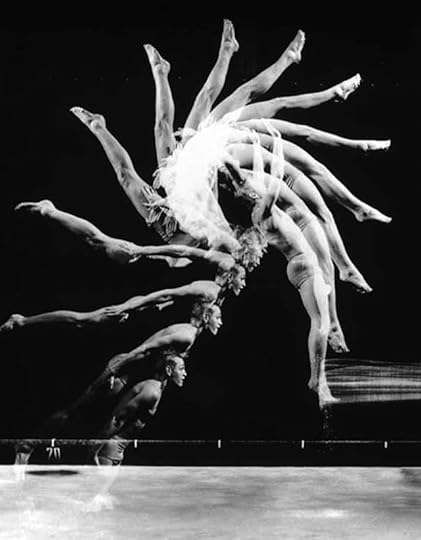
AND Marcel Duchamp's Nude Descending a Staircase (1912)
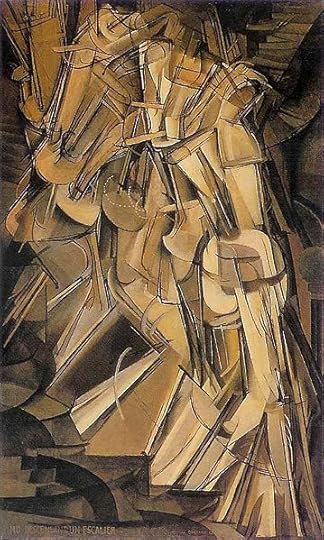
Just as I was wondering how he perceived his work as timeless...immortal...the Narrator/Proust turns his focus on the young people in the room with no memory or knowledge of what went before; stories and knowledge of relationships evolve and morph much as he now realizes occurred when he himself was a young man stepping into this world...history repeats itself...life goes on...and there are truths that will live as long as human beings exist.
 Marcus wrote: "Kalliope wrote: "Marcus wrote: "Kalliope wrote: "]Another mention of the mirror element, which should please Marcus.,..
Marcus wrote: "Kalliope wrote: "Marcus wrote: "Kalliope wrote: "]Another mention of the mirror element, which should please Marcus.,....."
And more mirrors, Marcus...
...les images que nous voyons assemblées ..."
I loved your idea, whether it is thanks to chocolate or not.
Since most of us do not have a perfectly symmetrical face, we do not see our face as others see us, because we see ourselves mostly through the mirror. That is why we often do not recognize ourselves in photos. We are used to the mirror image, which does not correspond to the photo.
 Ce Ce wrote: "I laughed out loud at the turn of the magic lantern...when out spilled our beloved Mme Verdurin now the Princess Guermantes. Truly a house of mirrors, a fun house...it would be as disorienting as a..."
Ce Ce wrote: "I laughed out loud at the turn of the magic lantern...when out spilled our beloved Mme Verdurin now the Princess Guermantes. Truly a house of mirrors, a fun house...it would be as disorienting as a..."And Proust just drops that bombshell and then walks away and the reader is left wanting to hear more, wanting her to speak as the Princesse, wanting to see of it has changed her. Perhaps we'll get more of her later - I'm not finished this section yet....
 Ce Ce wrote: "I laughed out loud at the turn of the magic lantern...when out spilled our beloved Mme Verdurin now the Princess Guermantes.
Ce Ce wrote: "I laughed out loud at the turn of the magic lantern...when out spilled our beloved Mme Verdurin now the Princess Guermantes. Fionnuala wrote: "And Proust just drops that bombshell and then walks away and the reader is left wanting to hear more, wanting her to speak as the Princesse, wanting to see of it has changed her. Perhaps we'll get more of her later - I'm not finished this section yet.... "
LOL, Such an elegant bombshell. Written beautifully...I was reading the next sentence before it entirely registered. I swear I saw Proust winking and entirely pleased with yet another twist that delivers a surprise and a laugh of delight.
 Fionnuala wrote: "Marcelita, I know that you know the Recherche inside out, having read it many times. Perhaps there are others in the discussion who have also read it before or who have read the c..."
Fionnuala wrote: "Marcelita, I know that you know the Recherche inside out, having read it many times. Perhaps there are others in the discussion who have also read it before or who have read the c..."Jocelyne wrote: "Yes, absolutely! Thank you, Marcelita. I can just imagine how sometimes you must be itching to just correct us or lead us back on track."
My gratitude to Marcelita as well...for your patience and delight with our discoveries...and your remarkable wealth of sharing.
Also, since I have been at least a few weeks behind much of this year...my heartfelt thanks to all of you for your fascinating comments, links, images...and knowledge.
Knowing the threads were here with each of you was invaluable. You have created a great resource for future readers of Proust.
I am delighted to be caught up and reading the last section with you this last week of the YORP.
Thank you...truly, Thank you...
 Marcelita wrote: "In trying to find the answer to the "cubist woman," I discovered this...
Marcelita wrote: "In trying to find the answer to the "cubist woman," I discovered this..."Comte and Comtesse Étienne de Beaumont give a New Year’s Eve party. Marcel Proust arrives about midnight. Jean Hugo tells us: 'He had entered with the New Year, the year of his death ."
Thank you, Marcelita...this is heartbreaking. We know Marcel dies but this lends another layer of poignancy to his final year and months.
 Ce Ce wrote:I am delighted to be caught up and reading the last section with you this last week of the YORP.
Ce Ce wrote:I am delighted to be caught up and reading the last section with you this last week of the YORP.Way to go Ce Ce! I too, just finished this week's section which has put me in a melancholic mood.
Regarding the links I share, I have to say that I almost always forget how hesitant so many of you are to reading secondary sources or outside reflections, and prefer depending on your own. For me, as a reader, I am always ready to entertain an informed opinion. Different strokes for different folks. I just feel like saying, you may be missing something.... and I hate for you to miss out.
 ReemK10 (Paper Pills) wrote: "Regarding the links I share, I have to say that I almost always forget how hesitant so many of you are to reading secondary sources or outside reflections, and prefer depending on your own. For me, as a reader, I am always ready to entertain an informed opinion. Different strokes for different folks. I just feel like saying, you may be missing something.... and I hate for you to miss out."
ReemK10 (Paper Pills) wrote: "Regarding the links I share, I have to say that I almost always forget how hesitant so many of you are to reading secondary sources or outside reflections, and prefer depending on your own. For me, as a reader, I am always ready to entertain an informed opinion. Different strokes for different folks. I just feel like saying, you may be missing something.... and I hate for you to miss out."Speaking for myself I am grateful links will be here to peruse over time as I process thoughts about what I have read this year. Your research always looks fascinating.
LOL, Ms Reem...since I have been so perpetually delinquent it is a good thing I determined early to maintain focus on the book. There is a method to my madness! ;-)
 Ce Ce wrote: "I laughed out loud at the turn of the magic lantern...when out spilled our beloved Mme Verdurin now the Princess Guermantes. Truly a house of mirrors, a fun house...it would be as disorienting as a..."
Ce Ce wrote: "I laughed out loud at the turn of the magic lantern...when out spilled our beloved Mme Verdurin now the Princess Guermantes. Truly a house of mirrors, a fun house...it would be as disorienting as a..."When I read this for the first time...I was stunned and angry, because I loathed Mme Verdurin's cruelty, lies and manipulation. Grrrrrr....
Thinking of a friend's step-mother may have influenced me. ;)
The theatre returns:
"He (Duc de Duras) had served as a useful transition for Mme Verdurin, who now, by a third marriage, had become Princess de Guermantes and occupied in the Faubourg Saint- Germain a lofty position which would have caused much astonishment at Combray, where the ladies of the rue de l'Oiseau, Mme Goupil's daughter and Mme Sazerat's step-daughter, had during these last years, before she married for the third time, spoken with a sneer of 'the Duchesse de Duras' as though this were a role which had been allotted to Mme Verdurin in a play." MP
 Another theatre reference....and the tragic paragraph, especially if this has happened to a friend.
Another theatre reference....and the tragic paragraph, especially if this has happened to a friend. "For me, in this purely nominal identity, in the fact that there was once again a Princesse de Guermantes and that she had absolutely nothing in common with the one who had cast her spell upon me, who now no longer existed and had been robbed of name and title like a defenceless woman of her jewels, there was something as profoundly sad as in seeing the material objects which the Princess Hedwige had possessed— her country house and everything that had been hers—pass into the possession and enjoyment of another woman. (Me: And one who is truly undeserving.)
"The succession of a new individual to a name is melancholy, as is all succession, all usurpation of property; and yet for ever and ever, without interruption, there would come, sweeping on, a flood of new Princesses de Guermantes--or rather, centuries old, replaced from age to age by a series of different women, of different actresses playing the same part and then each in her turn sinking from sight beneath the unvarying and immemorial placidity of the name, one single Princesse de Guermantes, ignorant of death and indifferent to all that changes and wounds our mortal hearts." MP




We do not see our own aspect. We only see the way the others look, through an opposite mirror.
Car nous ne ..."
This idea always makes me think of Sartre's No Exit. There were no mirrors in the enclosure.